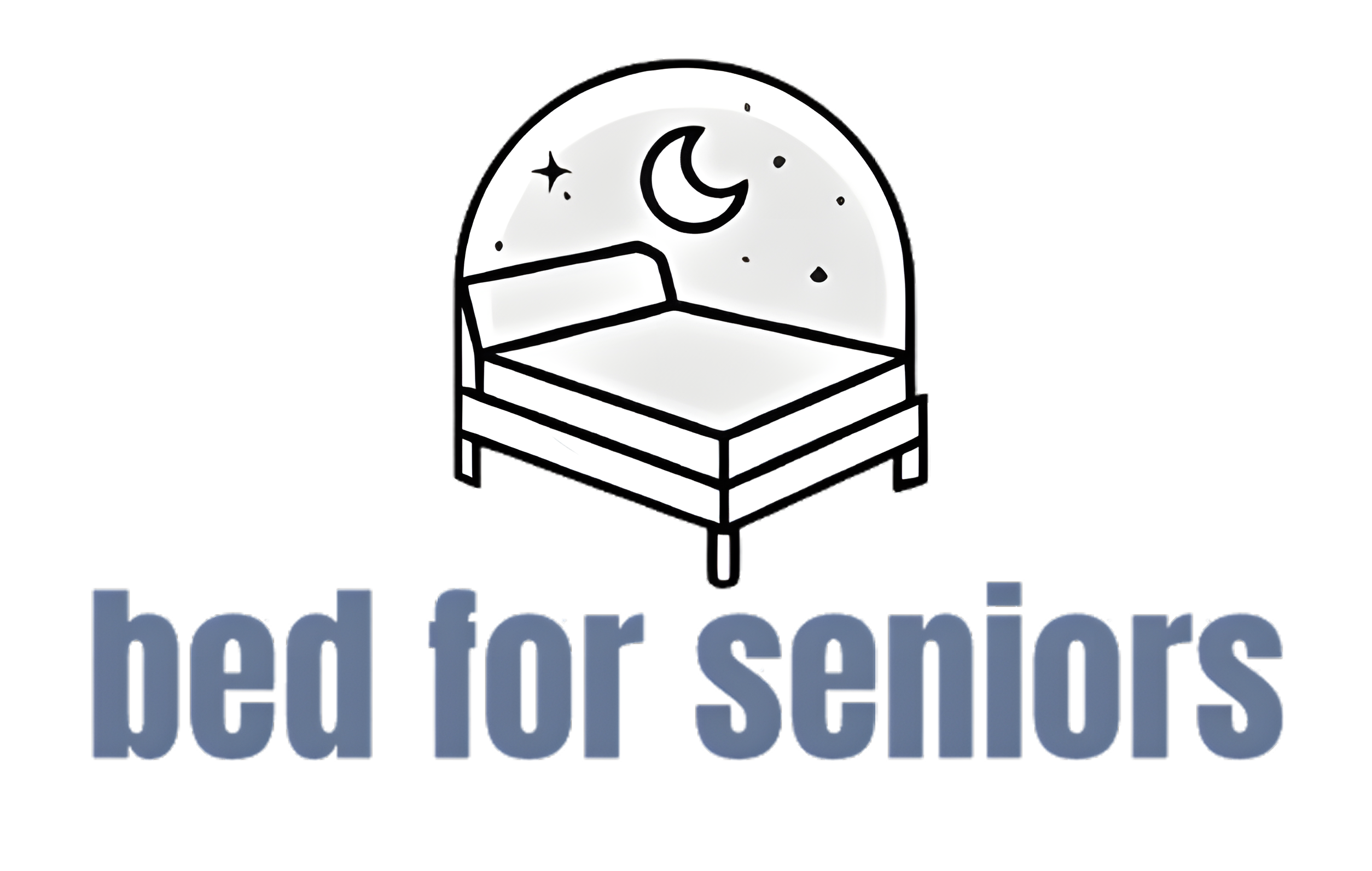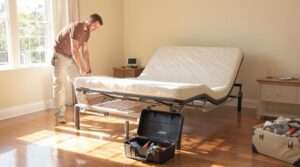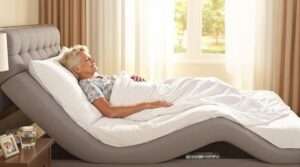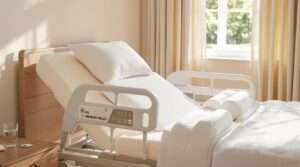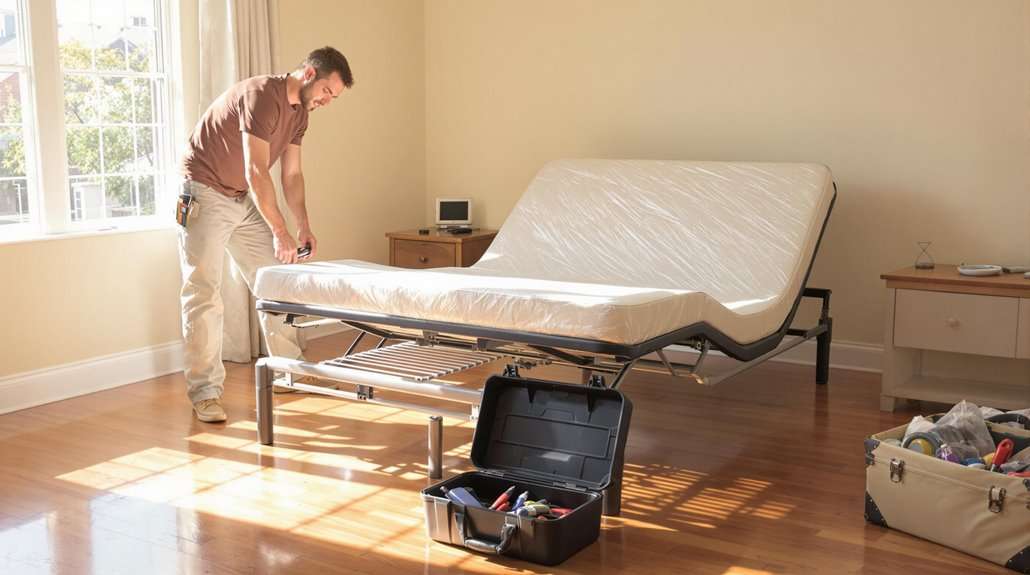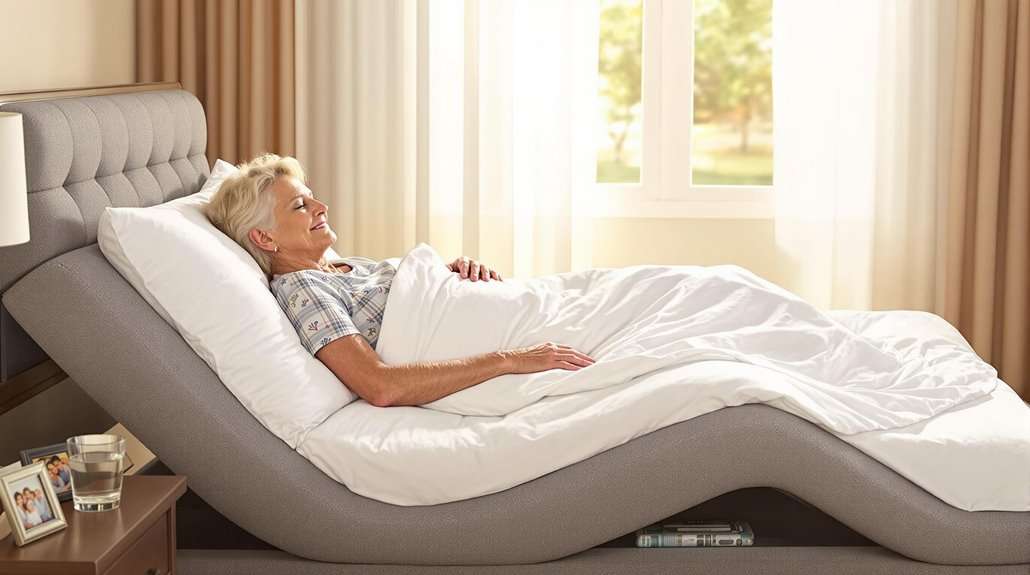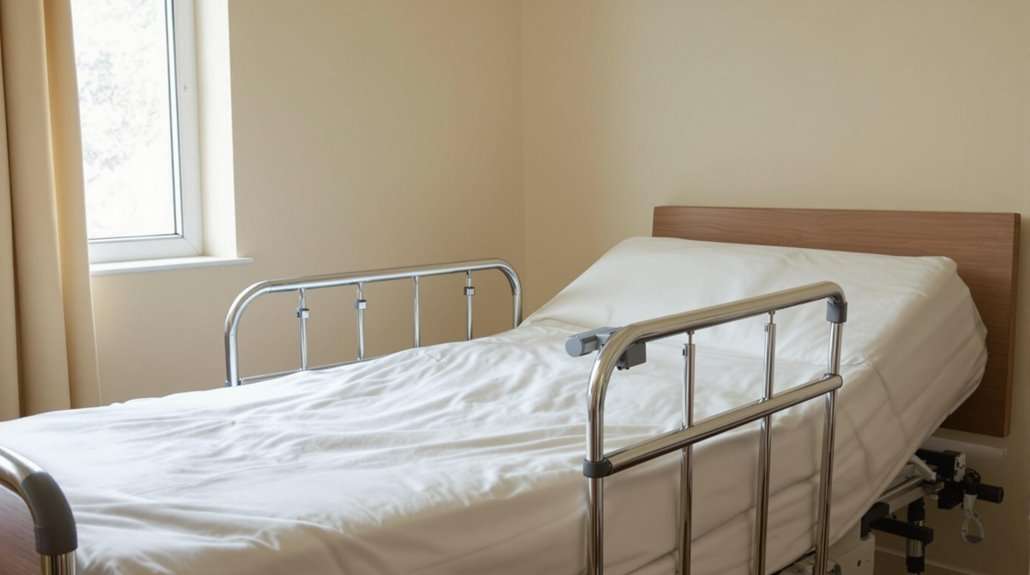Choosing the right bed for a senior can be difficult. Hospital beds and adjustable beds each have unique features. This article explains their differences and benefits. Find the best bed for your loved one today.
📋✅
- Hospital Beds vs. Adjustable Beds: Hospital beds can adjust head, foot, and height. They have safety rails and are made for medical use. Adjustable beds are for home use and focus on comfort and style.
- Safety Features: Both bed types have safety rails to prevent falls. Hospital beds use medical materials to keep infections away. Adjustable beds have battery backups for power outages.
- Adjustability: Hospital beds offer more adjustments like height changes. Adjustable beds let you move the head and foot with electric controls and may include massage settings.
- Cost and Insurance: Adjustable beds cost between $300 and $7,000. Hospital beds are more expensive. Medicare may cover hospital beds if needed for health, but adjustable beds often need out-of-pocket payment.
- Design and Comfort: Hospital beds look like medical equipment and have wheels. Adjustable beds look like regular home beds and come in stylish designs. They help seniors stay comfortable and safe at home.
Defining Hospital Beds vs. Adjustable Beds

Hospital beds support medical needs with height adjustments and safety rails. Adjustable beds let seniors change their position for better comfort and mobility.
Hospital Beds
Hospital beds are medical-grade beds used in healthcare settings. They offer manual or electric adjustments for the head, foot, and height. Equipped with side rails, they enhance patient safety.
These beds are mobile, featuring built-in wheels for easy movement. Specialized mattresses provide pressure relief, preventing bedsores. Made from medical-grade materials, they support infection control.
Next, explore how adjustable beds differ from these hospital beds.
Adjustable Beds
Adjustable beds are made for home use, focusing on comfort and style. They have electric controls to move the head and foot parts. Many models include massage features for relaxation.
Wireless remote controls make it easy to adjust settings. These beds come in stylish designs that fit with any home decor. They work with different mattress types, ensuring a comfortable sleep.
For seniors, adjustable beds offer important support and safety. Being able to change positions helps with mobility and health needs. Custom options allow each person to personalize their comfort.
Long-term value makes these beds a great choice. Features like head and foot adjustments and massage functions meet the specific needs of both seniors and caregivers.
Key Differences Between Hospital Beds and Regular Beds
Hospital beds offer more adjustability and built-in safety features than regular beds. Their design and structure are specifically made to support the unique needs of seniors.
Adjustability
Adjustability sets adjustable beds apart from regular beds. Hospital beds offer manual or electric adjustments for the head, foot, and height. In contrast, adjustable beds use electric controls to change the head and foot positions only.
These beds also include features like massage settings, enhancing comfort. This flexibility allows caregivers to customize the bed to meet seniors’ specific needs.
Next, explore the safety features that make these beds essential for senior care.
Safety Features
Adjustable beds include safety rails to help prevent falls. Hospital beds have built-in side rails for added security. Bed rails offer essential safety precautions for seniors. Depending on needs, adjustable beds can add optional rails.
Both types focus on patient safety through these features.
Emergency battery backups in adjustable beds ensure they return to a flat position during power outages. This supports emergency preparedness in home healthcare settings. Hospital beds use medical-grade materials to prevent infections.
These materials help control infections and maintain a clean environment. Safety features in beds protect seniors and enhance their care.
Design and Structure
Design and structure also distinguish hospital beds from regular beds. Hospital beds have a clinical appearance with sturdy bed frames typical of medical equipment. In contrast, adjustable beds look like traditional bedroom furniture and fit seamlessly into home decor.
These beds come in stylish designs and support various mattress options, enhancing both appearance and comfort.
Advantages of Adjustable Beds for Seniors
Adjustable beds give seniors more comfort and support. They can be changed to fit each person’s needs, making daily life easier.
Safety and Support Features
Safety and support features in adjustable beds enhance fall prevention and injury prevention for seniors. Safety rails secure the bed without creating an institutional look, providing peace of mind.
Easy-to-operate controls accommodate limited dexterity and vision, ensuring seniors can adjust their beds independently. Adjustable height helps caregivers lift and position beds smoothly, reducing back strain and improving caregiver support.
These elderly-friendly features use assistive technology and mobility aids to create a safe and comfortable sleeping environment.
Supportive features include sturdy frames and materials that offer stability and durability. Bed designs incorporate mobility aids, allowing easy transitions in and out of bed, which reduces fall risks.
Caregivers benefit from beds that can be customized to individual needs, enhancing customization and personalization. Adjustable beds provide long-term value by adapting to changing health requirements, ensuring sustained support and safety for both seniors and their caregivers.
Customization and Personalization
Adjustable beds offer custom comfort for seniors. They allow individualized sleep positions, which help those with chronic pain or arthritis. Seniors can choose mattress firmness and split designs to match their needs.
Elevating the legs improves blood circulation, reducing swelling and discomfort.
Personalized features enhance daily life. Adjustable beds make it easier to read, watch TV, or use a laptop comfortably. These beds adapt to each person, providing a modified sleeping and living experience.
Customized options ensure that every senior enjoys the support and ease they need.
Long-Term Value
Adjustable bed frames offer significant long-term value for the elderly. They improve sleep quality by allowing comfortable sleep positions, which help reduce chronic pain and arthritis discomfort.
Elevating the head or feet can enhance respiratory health and lessen sleep apnea symptoms. Zero gravity positions distribute body weight evenly, providing better support and reducing pressure points.
Over time, these features help lower fall risks and alleviate various health issues, making adjustable beds a cost-effective choice.
Investing in adjustable beds also means customization and personalization for each senior’s needs. Caregivers can adjust the bed to fit specific health requirements, ensuring ongoing comfort and safety.
This flexibility supports better overall well-being and independence for the elderly. The durability and advanced safety features of adjustable beds ensure they remain beneficial for many years, providing lasting value and enhancing the quality of life for seniors.
Comparing Cost and Insurance Coverage
Compare the costs and insurance coverage of senior beds to find the right option for your loved one—read on to discover more.
Cost Differences
Adjustable beds range from $300 to $7,000, with most models priced between $899 and $3,596. Hospital beds cost more, creating significant cost disparities. Adjustable beds offer better affordability and economic value for home use.
Insurance coverage options vary. Some insurance benefits may cover adjustable beds, depending on the plan. Coverage variations can enhance cost-effectiveness. This makes adjustable beds a more affordable choice for caregivers managing expenses.
Insurance Coverage Options
Medicare may cover hospital beds if a doctor says they are medically necessary. Hospital bed coverage falls under Medicare Part B. Adjustable beds might also be covered by insurance when a medical need is documented.
Without medical necessity, adjustable bed expenses are usually paid out of pocket. Compare the costs of hospital beds and adjustable beds to understand your options.
Third-party financing is available to help with the cost of adjustable beds. Review your health insurance options to see what is covered. Evaluate your insurance coverage to determine if an adjustable bed qualifies for support.
Understanding insurance cost comparisons can help manage personal expenses effectively.
Choosing the Right Bed for Senior Needs
Assess mobility and health needs to find a bed that ensures comfort and safety for seniors—read on to learn more.
Assessing Mobility and Health Requirements
Evaluate each senior’s mobility and health needs carefully. Thirty-four percent of adults over 60 face sleep struggles. Medical conditions like arthritis or Parkinson’s can affect sleep quality.
Reduced activity levels also lead to sleep issues. Identify specific health requirements, such as the need for easier bed access or specialized support. Choose beds that enhance independence, supporting seniors to move and adjust their beds without assistance.
Adjustable beds offer features that improve comfort and safety, addressing both mobility and health challenges. These options help improve the quality of life for the elderly by meeting their unique sleeping needs.
Importance of Comfort and Ease of Use
Adjustable beds ensure elderly comfort with chronic pain relief and arthritis support. Over 90% of older adults report better sleep using seniorfriendly beds. Easy-to-use controls accommodate limited dexterity and vision.
These home decorfriendly beds offer customization and ease of use, fitting seamlessly into any room.
Choosing the right bed can greatly improve a senior’s comfort and safety. Adjustable beds offer features like customizable positions and safety rails that regular beds do not. These beds support better circulation and make getting in and out easier.
Investing in a senior-friendly bed enhances daily living and overall well-being.
Related Questions
1. What features make senior beds different from regular beds?
Senior beds have adjustable bases, making it easier to change positions. They often include side rails for safety and easier getting in and out. These beds may also have built-in storage to help keep essentials close.
2. Are senior beds better for health than regular beds?
Yes, senior beds can improve health by providing better support and comfort. Adjustable settings help reduce pain and pressure points. They also aid in proper circulation and can make breathing easier.
3. How do senior beds assist with daily activities?
Senior beds make daily activities simpler. With adjustable heights, it’s easier to sit up or lie down. Side rails help prevent falls, and the design often allows for easier access to the bed for both the user and caregivers.
4. Can senior beds be customized for individual needs?
Absolutely. Senior beds can be tailored to fit personal preferences and medical requirements. Options include different mattress types, control systems for adjustments, and additional accessories like reading lights or USB ports.
